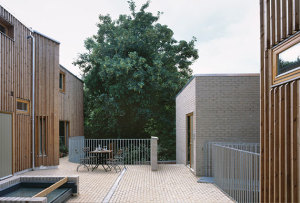 With more and more people priced out of buying centrally, co-living is coming to the fore. Michelle Perry investigates the projects that are allowing tenants to live both communally and independently
With more and more people priced out of buying centrally, co-living is coming to the fore. Michelle Perry investigates the projects that are allowing tenants to live both communally and independently
Co-living? Collective living? Community living? You’d be forgiven for thinking of something akin to communes or student houses. But co-living might just prove a solution to the housing shortage and a good investment alternative to PRS.
Based on the traditional flat share, co-living is a new concept of residential space. Think halls of residence-style rooms and communal living spaces with modern amenities and serviced apartment facilities.
Typically aimed at young professionals launching their careers in a city, co-living aims to create a contemporary sense of community coupled with personal space.
Bills are all-inclusive and services such as a concierge and room cleaning come as standard. Shared facilities can include dining rooms, libraries, communal gardens, bars and roof terraces. One development even offers a disco launderette.
For the investor, there are economies of scale much the same as PRS and revenue per sq ft 25-30% higher than conventional private rental – but there are still some risks.
The advantages to the tenant are living with similar-aged people, all the mod cons and a swanky new building in a good location. No letting agents, multiple viewings or lengthy leases.
In May, the newest co-living development opened its doors in Willesden Junction, north-west London – a 21-minute Tube ride to Oxford Circus. Owned by property and management company The Collective, Old Oak is the company’s first example of a large-scale co-living development in the UK.
Rents for a ‘twodio’ – an en suite room measuring 100 sq ft with small double bed and a shared kitchen – averages £1,100 a month. From September, the minimum tenancy will be nine months.
Old Oak can house 546 people on 10 floors and offers tenants a chance to live close to the city centre without having to stump up the increasingly hefty deposits required to buy in London. Other benefits include the option of using a shared spare room if you want friends or family to stay, at a cost of £30 per night.
A back-of-the-envelope calculation for the annual income for The Collective, if all the rooms are full, would be in excess of £7m. Naturally that doesn’t factor in ongoing annual costs, but there are also significant economies of scale for services such as electricity, cleaning and maintenance.
Extra income stream
If bills are all-inclusive in co-living, services could be bought in bulk and “could even provide an extra revenue stream” for developers, says Nick Whitten, director at JLL.
Empty rooms for prolonged periods are a risk but equally, if the shortage of housing continues, there could be a ready-made market.
Arguably, co-living is a concept better suited to large urban areas, and particularly London, where young people gravitate for jobs but the housing crisis remains the most acute.
In a survey carried out by JLL, more than three-quarters of first-time buyers who responded (819 people) would rather have a smaller home in a good location than a bigger one in a less desirable location.
 “One of the fundamental issues of the housing crisis is that people want to live in London but cannot due to price,” says Whitten. “People are prepared to sacrifice space over location, so what developers are doing is cutting space to deliver projects at 80% of the price.”
“One of the fundamental issues of the housing crisis is that people want to live in London but cannot due to price,” says Whitten. “People are prepared to sacrifice space over location, so what developers are doing is cutting space to deliver projects at 80% of the price.”
Rents may be higher for tenants, but what they get in return is consistent quality and service.
“Like student housing and senior living, co-living works successfully when places are made aspirational and desirable. Places where people want to live but also be seen to live,” says Paul Wells, associate at architects Dexter Moren Associates.
Co-living could also prove popular for another demographic – the older generations – because of the mix of personal space and independence, with shared facilities such as communal gardens and kitchens. Sheltered accommodation and private nursing homes are arguably a hangover from the last century and do not provide what baby boomers want or will need in the future.
Whitten says this option could be the most lucrative for co-living developers because it is the baby boomers who have the assets to cash in for their future. In older age, many people tend to shun cities and move to smaller towns or the countryside, so for developers looking to invest in sites outside cities where land is cheaper, the opportunity could be ripe.
In its current form, co-living is unlikely to be a long-term solution to the housing crisis, but it does offer an innovative alternative and should provide food for thought for developers and architects for the longer term.
 Co-Housing: taking co-living a step further
Co-Housing: taking co-living a step further
Not all alternative housing developments focus on young professionals. Neither are they so dependent on location, but rather like-minded, progressive groups of people.
In 2006, Springhill Cohousing unveiled the UK’s first new-build co-housing scheme near the centre of Stroud in Gloucestershire with 34 homes, ranging from one-bedroom flats to five-bedroom houses. In this alternative living solution, there is a three-storey common house with a shared kitchen for activities to take place, and which forms the focus of the community.
Co-housing can work in big cities, too. London’s first co-housing project, designed by architect Henley Halebrown Rorrison, became home to seven adults and six children in 2014. None of the families fitted into the traditional sense of a nuclear family – and none of them were friends before the project began.
Located in Stoke Newington, north London, 1–6 Copper Lane is a development of six homes with shared laundry facilities and communal hall and gardens. All the homes have their own kitchens, so it is a more modern take on the classic co-housing model pioneered in Denmark in the 1970s.
Simon Henley, director at architect HHR, says: “It is particularly suited to working families who need help with childcare or older people who are single and want support.”
In its current form, co-housing is small scale and perhaps not a solution to the housing crisis, as it is perhaps too eccentric for the average Brit.
But Henley argues that it should not be ruled out as a future option if developers can find a way to create projects on a larger scale, such as Florida condominiums.











